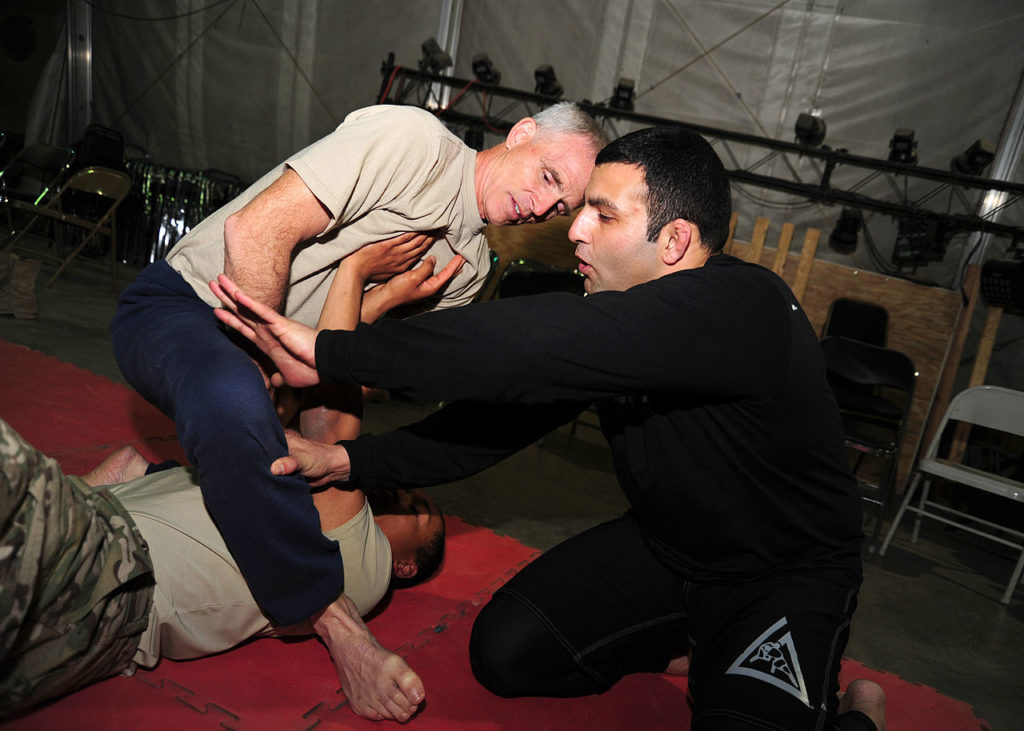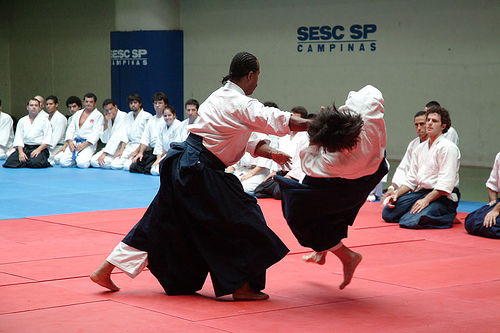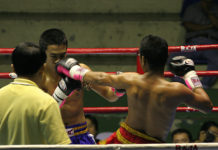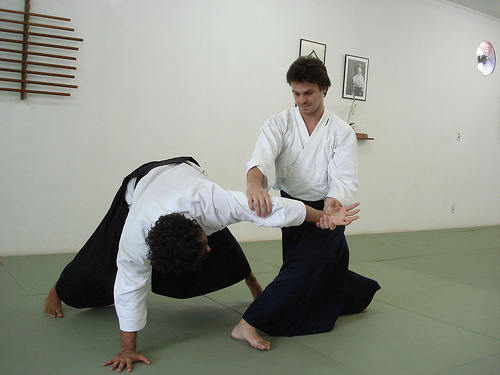BJJ vs Aikido
BJJ and aikido are both grappling based martial arts that have a widespread following. When it comes to comparing BJJ vs aikido, there are additional factors you must consider beyond other style vs style comparisons. Overall, BJJ and aikido do share some similarities. However, there are some key foundational differences between BJJ vs aikido that we must discuss to give the complete picture on these martial arts.
In today’s article, we break down BJJ vs Aikido in terms of technique and philosophy so you can decide for yourself which martial art you think is better for you.
Since you are likely familiar with the basics of BJJ technique, purpose, and philosophy, we are going to jump right into discussing Aikido and then comparing the two arts.
What is Aikido?
Aikido is a Japanese martial art that was developed in the 1920s and 1930s by Morihei Ueshiba, known as “Osensei” by many Aikido practitioners. Ueshiba trained in many different Japanese martial arts styles including Daito-ryu Aiki-jujutsu, Judo, and Kenjutsu swordsmanship.

According to Gaku Homma’s 1997 book The Structure of Aikido, much of the technical aspects of Aikido derives from Daito-ryu Aiki-jutsu and the swordsmanship and weapons training from traditional Kenjutsu.
Aikido Techniques
Aikido techniques are primarily based on countering specific strike patterns with various throws. Most throws end in a joint-lock or pin. Commonly, Aikido throws rely on wrist manipulation and ‘redirecting the attacker’s energy’ to cause the tori to throw the uke into an impressive looking flip and finish with some form of wrist or arm lock.
The following demonstration from Ueshiba Moriteru Doshu gives a good overview of some beautiful Aikido techniques.
Most of Aikido is practiced in this way – that is – performed as katas between a non-resisting uke who feeds specific ‘attacks’ to the tori.
If you compare this to BJJ techniques, you will notice much more ‘flow’ in Aikido. Even compared to the standup component of BJJ – which is essentially just wrestling and Judo – Aikido appears much more ‘dance-like.’
Certain forms of Aikido incorporate katas with traditional weapons such as Japanese swords.
Aikido Philosophy
Unlike BJJ and many other modern martial arts practices, Aikido has an incredibly deep philosophical component. In fact, in many ways, Aikido philosophy resembles its own religion. Without getting too bogged down in nitty-gritty, Aikido philosophy promotes the idea of harmony, peace, and defeating opponents without causing physical harm.
On the far end of the spectrum, Aikido goes deep on concepts such as ki, which has a number of meanings but roughly translates to “life energy.” Different schools of Aikido, such as the Yoshinkan hardstyle have different interpretations of ki that have more practical implications, such as ‘the timing and application of the whole body’s strength to a single point.’
Aikido Competition
While most schools of Aikido do not involve competitions, the Shodokan or Tomiki Aikido style does have a competitive aspect. The following video shows some highlights from an Aikido competition.
Note that many practitioners will vehemently deny that this is ‘real Aikido.’ In fact, for what it’s worth, many of the ‘live’ Aikido videos are littered with this exact criticism in the comments section. Nevertheless, at a certain point we need to use some examples of Aikido against real resisting opponents.
BJJ vs Aikido: A Technical Analysis
The obvious difference between BJJ and Aikido is the focus on groundwork versus stand-up techniques. The majority of BJJ standup grappling is a combination of wrestling and Judo techniques, and whatever else that might work to take an opponent to the ground. Unfortunately, many BJJ schools neglect any form of standup training.
From a mechanical perspective, Aikido techniques might ‘work’ in the sense that the tori applies pressure to the uke that causes pain, possible damage, and a ‘submission.’ Speaking for myself, I have no doubt that the uke is not comfortable when the tori applies the various finishes, we see in the demonstration videos.
However, as MMA commentator Jack Slack writes in his excellent breakdown of Aikido from an MMA-style analysis, ‘mechanically sound doesn’t mean practical.’
Aikido finishes do not appear to control the uke’s body
When I watch the Aikido demonstrations from a BJJ perspective, the biggest thing I notice is that the tori are not actually controlling the ukes’ body during the application of a submission. In many of the finishes, the uke is limp on the ground while the tori applies a wrist lock technique.
The first thing that comes to mind is that it’s almost like finishing an omoplata without controlling the opponent’s hips to prevent a forward roll. There is nothing keeping the uke from rolling forward and standing up. An omoplata will break your shoulder, but if the opponent does not stop you from rolling and you tap out… that is on you.

Every BJJ submission has some method of controlling the opponent’s ability to move the rest of their body. In fact, that is essentially what makes it an actual BJJ submission.
I can do an ‘armbar’ by standing next to you, grabbing your wrist, and pushing on your elbow. If you do not move or flex, your elbow will break. Mechanically, it ‘works.’ However, that does not make it practical, because anyone with their head on straight is going to flex, reposition, and immediately get out of the technique.
Of course, I am generalizing about Aikido. But after watching quite a few Aikido demonstrations while procrastinating for this article, I have not found an Aikido finish that looks like it does not depend on the guy going limp for no practical reason.
Even the wristlock techniques in Aikido would require proper ground control to work in real life. Wristlock techniques work, but you need to keep the opponent from just moving away from the pressure.
Aikido throws rely on unrealistic attacks
If you watch any of the high-level Aikido demonstrations, the throws rely on lots of wrist control and shoulder-locks while standing. In many cases, the tori are applying an ‘Americana’ external rotation of the shoulder that causes the uke to do a dramatic backflip.
The thing is the tori almost always establishes the wrist control off an unrealistic attack from the uke. There is no grip fighting, pummeling, or attempt to break posture. The entire technique is predicated on an attack that is simply unrealistic for anyone with a modicum of grappling or striking experience.
If you give up a wrist and offer no further resistance, these throws might work. However, against a halfway decent Judoka or wrestler these throws are not realistic.
Aikido has better breakfalls than BJJ

One big issue with BJJ is the lack of standup training. In particular, the lack of break fall technique training. Aikido on the other hand has an excellent variety of breakfall techniques that keep the uke safe during the execution of more advanced Aikido throws.
This is not unique to Aikido, of course. Arts such as Judo have you practice breakfalls for a while before being allowed to practice throws. However, Aikido certainly excels at breakfall techniques. In fact, a BJJ practitioner at a school that neglects standup is more likely to be injured if they are thrown than someone who has a good base of Aikido in terms of breakfalls.
Many Aikido throws might be questionable against full resistance. However, you cannot deny that flipping over your head in a 6-foot arc and safely landing requires a good knowledge of proper break falling.
BJJ vs Aikido: A Philosophical Perspective
No comparison of BJJ vs Aikido would be adequate without addressing the philosophical side of the arts.
Brazilian Jiu Jitsu and Aikido have quite different philosophies. In fact, this may be a bigger difference than the techniques themselves.
Despite the valid criticisms of sport BJJ from a self-defense perspective, BJJ in its origins is primarily about effective fighting techniques. In practice, BJJ is constantly evolving because competition is part-and-parcel of the art itself. As such, BJJ has a highly active ‘meta-game’ and is constantly evolving.
Aside from the Shodokan style, Aikido lacks serious competitive development. This can lead to stagnation in the art and does not filter for’ what works and doesn’t work against full resistance.
Depending on who you are as a martial artist, the lack of ‘aliveness’ in Aikido may not bother you. In many ways, Aikido practice may be better for your body in the long run. Aikido is a beautiful practice and there is no denying the grace and fluidity of movement when an Aikido master demonstrates their technique.
If your goal is self-defense, you probably already know there are better options than Aikido for your base martial art. Furthermore, you need to know more than just BJJ if you want well-rounded self-defense or plan to fight in MMA.
Concluding Thoughts: BJJ vs Aikido
The bottom line is no martial art is perfect. Aikido has its flaws and purpose as does BJJ. Most people who practice Aikido are not doing so to use it in a fight.
Despite my less-than-reverent take on most things, we must acknowledge that martial arts are about more than just fighting. For those who are dedicated to the path of Aikido, we have nothing but respect.
For a long-form, in-depth discussion of Aikido and BJJ from someone who truly knows both arts, we recommend checking out this interview with Roy Dean, who holds black belts in BJJ as well as Aikido and Japanese Jujitsu.
Explore similar topics:
Explore other topics:
- The Best BJJ Strength and Conditioning Program
- Essential No Gi BJJ Gear
- The Best Jiu Jitsu Documentaries





